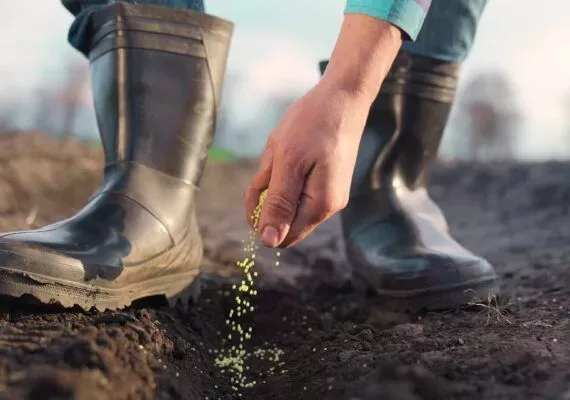
Onions grow best in soil with a crumbly structure. It should have well-regulated water-air and temperature ratios. Onions poorly tolerate inappropriate soil pH. It grows best at a pH of 6.6–7.0 in mineral soils or a pH of 5.5–6.5 in peat soils. If the pH is not properly regulated, the plants will start to grow poorly, with the emerging leaves turning pale green, and their tips slowly yellowing. Therefore, it is extremely important for agriculture as a whole to conduct liming procedures. Lime application is now even carried out in green areas.
Crop Rotation
To ensure that onions produce abundant yields, it is necessary to adhere to crop rotation principles. Onions should not be planted in the same location more often than every four years. This limits the occurrence of onion pests and pathogenic pathogens. Onions can be planted after carrots, beets, peas, cabbage, beans, or cereals, after which the field will not be weedy. This is a very important aspect because young onions are very sensitive to weed presence. Crop rotation of vegetables is an important practice aimed at minimizing the occurrence of plant diseases and pests.
Recommended Fertilizer Rates
For onion cultivation, it is very important to provide the right amount of nutrients to the soil. To enable the plant to absorb nutrients, it is necessary to establish the appropriate soil pH. Nitrogen is one of the particularly important elements for onion cultivation. It should be supplied from 100 to 150 kg per hectare, in two doses. The first should be applied in pre-sowing form, and the second as a top dressing when the onion has 1 to 4 true leaves. However, nitrogen should not be applied to onion fields later than June 15th. Applying it after this time may deteriorate the quality of the vegetables and also lead to a delay in the leaf wilting.
Another important element for this plant is phosphorus – it needs from 100 to 150 kg per hectare. The entire dose should be applied before sowing onions. Phosphorus ammonium phosphate fertilizer can be used for this purpose, which will provide the phosphorus dose and at the same time the starting dose of nitrogen.
The onion field also needs to be fertilized with potassium. It is sown in spring together with phosphorus fertilizer and the first dose of nitrogen. Potassium sulfate can be applied. Onions need a dose of potassium from 150 to 200 kg per hectare.
This plant also requires sulfur in a dose of 40 to 100 kg per hectare. However, before applying any elements to the onion field, it is worth conducting soil tests in a laboratory to know exactly what nutrient deficiencies the soil has in a given area.
Liming the Onion Field
Due to the onion’s high sensitivity to pH fluctuations and too much soil acidity, liming is necessary. This vegetable needs from 400 to 600 kg of lime per hectare. Lime can be applied as top dressing or the field can be limed before planting onions.
In Poland, onion strip-row sowing is most commonly used. It involves spacing the tractor wheels at 135 cm intervals, allowing onions to be sown in rows every 27 cm. They can be single, double, or triple rows. Each row must be accompanied by a 54 cm wide strip to allow for passage.
WHAT ONIONS TO CHOOSE FOR CULTIVATION?
Among the many onion varieties, there are several particularly popular ones for cultivation in Poland. These include shallots, pearl onions, Wolska, Bonus F1, Medusa F1, and Bruce F1.
Shallot Onion
Shallot onion is particularly valued in the kitchen. It grows, forming clusters of small bulbs. It can overwinter in the ground, but is usually dug up during the season. It has a milder taste than other varieties. In July, its leaves dry up – then it is dug up and dried.
Pearl Onion
It can be preserved whole. It reproduces from small bulbs. It is a winter variety. It is planted in August, and the crop is harvested the following year, also in August. It does not store well after harvest and is suitable for quick consumption.
Wolska Onion
Wolska onion matures late but has evenly sized bulbs (they have almost the same shape and size). Their weight ranges from 90 to 160 grams. The variety is resistant to low temperatures and stores well.
Bonus F1
Bonus F1 is a very popular early-maturing onion variety. It has a small waste. It is easy to peel both by machine and by hand. It stores well. It is popular in the retail market, where it can be found in bags.
Medusa F1
Medusa F1 is described as the successor to Bonus F1 onion. It yields large, early crops. The bulbs have a fairly similar size (from 65 to 85 mm). This variety is resistant to May frosts. It can be stored until March of the next year, of course, after proper drying.
Bruce F1
Bruce F1 is characterized by its high dry matter content and even bulbs, which store very well. It is suitable for packing and storing in bags. This variety is described as an onion that remains practically the same after long storage as at the time of harvest.
WHAT CARE PROCEDURES SHOULD BE PERFORMED IN THE ONION FIELD?
Regardless of the types of soil found in Poland, it is necessary to carry out maintenance and protective procedures in the cultivation field. Onions require special attention when it comes to care.
Protection of Onions Against Pests
Crop rotation should help reduce the occurrence of onion pests. Unfortunately, sometimes they attack the plantation of this vegetable. In such cases, it is necessary to use pesticides to combat pests. It is important to strictly follow the label recommendations when dosing.
The most common onion pests are onion fly, onion thrips, onion leaf miners, onion maggot, onion root maggot, aphids, wireworms, onion seed corn maggot, wireworms, and onion leaf miners.
Protection of Onions Against Diseases
Onion cultivation can be affected by diseases. Crop rotation limits this phenomenon, but unfortunately does not completely exclude it. Most commonly, onions are attacked by white rot, pink root rot, downy mildew, damping-off, onion smudge, neck rot, Fusarium rot, onion purple blotch, bacterial rot, onion smudge, or yellow dwarf. To eliminate diseases that have attacked the crop, it is necessary to spray with a plant protection agent.
Weeding Onion Crops
Weeds are particularly dangerous for onions when the first seedlings appear. Therefore, it is necessary to carry out weeding procedures. If onions are grown with scallions, there is less risk of being overwhelmed by weeds. Soil loosening activities are important for onion growth. It is best to loosen the inter-rows using a cultivator. It is sufficient to loosen the soil to a depth of 3 cm.






